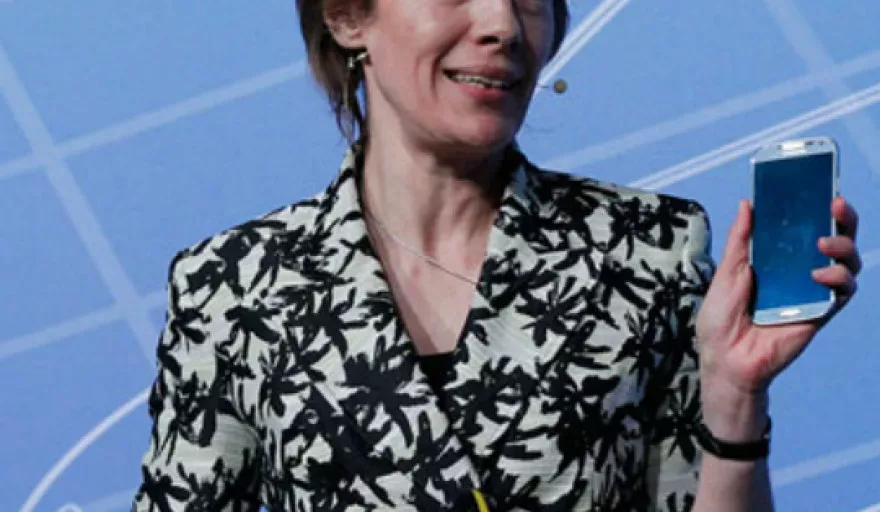Mobile World Congress 2015 (MWC) retains its title as one of the key technology events where captains of industry break news, showcase their latest innovations and even launch products big and small. Cnet described this years’ event as showing off “interest-piquing gadgets and big-name speakers proving that the mobile industry is still evolving in critical ways”.
From flagship smartphones and watches to the darn right weird and wonderful tech of the future, MWC is a platform that delivers year after year. Europe Outlook takes a look at some of the technological wonders debuting at the event, hand-picking some of this years’ most talked-about gadgets.
SMARTPHONES
Orange and Firefox to launch $40 phone in developing countries
Cheaper smartphones still play a vital role in connecting people in emerging countries around the world. In line with this mantra, Orange expect to sell millions of its new Klif device with Mozilla’s Firefox OS pre-loaded, and will be launching the phone in the second quarter of 2015 on a $40 package deal to 13 countries in Africa and the Middle East. The device will come bundled with six months of voice, text and data services.
At MWC, Mozilla identified that the low-budget category in developing nations would be an excellent entry point to get noticed and distinguish themselves from Google and Apple, whose software typically requires more powerful, expensive hardware.
“We will address this part of the population who still don’t have access to the internet,” Yves Maitre, Orange’s Executive Vice President of Connected Objects and Partnerships stated.
“In this part of the world, smartphone penetration is 11 percent. In sub-Saharan countries, it is around five percent.”
The Firefox OS will work in local languages that Android does not support. “They should be able to take the phone out of the box and start using it,” Yves emphasised at Mobile World Congress.
Growing momentum towards the launch of 5G
5G has been one of the most talked about progressions for some time now as companies compete to be the first to launch this LTE tech. The competition is hotting up as network equipment makers’ Ericsson and Nokia Networks both demonstrated 5G technology on the show floor at MWC. Touted to be a reality by 2020, 5G networks will transfer data much faster than today’s 3G and 4G and increase download speeds for streaming video and instant app updates.
“The 5G infrastructure is expected to become the nervous system of the digital society and digital economy,” said Günther Oettinger, the European Commission member whose job is to encourage that very digital development.
In terms of application of 5G outside of the mobile world, tech giant Huawei predicts a 50-fold improvement in responsiveness from 4G to 5G networks. Lower communication lags (or latency) helps applications like self-driving cars to respond more quickly.
Perhaps most crucially to the future of our world, 5G promises shorter communication delays that will enable fast-response services in a whole myriad of applications such as augmented reality and online gaming features which are currently impossible. The hope is that early trials of 5G will begin in 2018, with a globally standardised version of the technology starting in 2020.
DEVICES
LG launches new smartwatch with WebOS
The LG Watch Urbane LTE can make its own phone calls over LTE, mobile payments over NFC and uses a brand new operating system called the “LG Wearable Platform OS”, powered by WebOS. It has a whole host of new features that rival Android Wear is yet to be capable of, combining features from the Samsung Gear S and the Apple Watch in one device.
“The LG Watch Urbane LTE is an example of the kind of innovation that’s possible when you’re the industry leader in LTE technology,” commented LG President and CEO Juno Cho in a press release.
LG has also launched a smaller version of the watch powered by Android Wear, the LG Watch Urbane which would suggest it is a cheaper model, without the LTE/NFC functionality.
Back to the LTE version and LG says the device can be used to create a wrist-wallet that will pay for everything from cinema tickets to public transport. Moreover, the device packs a series of fitness features including an onboard heart-rate sensor, accelerometer and barometer, all designed to work with the new cycling, hiking and golfing modes.
Is LG right to ditch Android Wear as the primary OS for its smartwatches? Only time will tell if others will follow this trend in order to create the ultimate customisable super-watch.
HTC and Valve showcase the HTC Vive VR Headset
The HTC Vive proved that HTC and gaming giant Valve will be major contenders in the virtual reality market going forward. No cameras were reportedly allowed inside the room with the headset, making the 30 minute demo experience at MWC an up close and personal one.
The product and hardware is designed for PCs and works via a series of laser boxes mounted in the corners of the ceiling to track a person’s movement. Although an early prototype design, the controllers currently resemble a combination of the PlayStation Move controllers, the Nintendo Wii remote and Valve’s upcoming Steam controller.
Perhaps the biggest and most exciting piece of news to come from HTC at Mobile World Congress this year, the HTC Vive promises to be a great step forward in bringing virtual reality innovation to the masses.
TECH OF THE FUTURE
Project Ara update
Back in 2013, Project Ara was nothing more than a concept, named by Motorola as “PhoneBloks”. Instead of buying a phone that becomes obsolete within a matter of months, Ara adopts a modular design where the user can swap out old components for new ones. After being bought by Google, Project Ara Director, Paul Eremenko outlined the plans for the device this year at Mobile World Congress.
In the second half of 2015, Ara is due to be piloted in Puerto Rico as a result of the country’s diverse mobile user base, high mobile internet penetration rate (77 percent) and successfully arranged agreements with the local carriers and regulatory bodies.
Furthermore, Mobile World Congress was the platform which revealed the kinds of modules being designed for the phone such as different sized speakers, batteries and varying megapixel cameras.
As a result of its modular design, the user can spend as much or as little as they want in buying better components, making this phone an eventual versatile contender in a huge range of markets around the world. Google’s ultimate aim is to bring Ara to five billion people; namely the people who don’t currently have mobile internet access.
Bluesmart Carry-on smart suitcase
After raising $2 million on Indiegogo, the Bluesmart Carry-on prototype made its debut at MWC and has some interesting features. For starters, the case has a SIM-card embedded inside it and this is included in the price, courtesy of a partnership with mobile operator Telefonica. Should your case get lost, the SIM provides the cases location on a map via the accompanying app.
Ingeniously, the Carry-on can be unlocked using the app too, and you can tweak the settings to determine how far you have to be from the case before it unlocks. It can also send you a text if it gets too far out of range, a useful tool that complements the locator aspect so that you do not accidently leave it behind.
A great little extra feature of the app is its ability to show you how far your bag has travelled, and provide a visual representation of its journeys around the globe.
The travel companion can also weigh itself with sensors when you lift it off the ground, this feature is reportedly 90 percent accurate and will no doubt be fine-tuned in the final model. As an added extra, the Carry-on has a 10,000mAh battery on board, which will keep the bag’s functioning for a staggering six months. However, if you want to make use of this stored-up power to charge your phone and gadgets via USB, you can – six times over!
IKEA Qi-powered furniture
From wireless suitcases to wireless furniture and IKEA is launching a new line of goods with built-in wireless charging functionality. The Swedish manufacturer announced that its Qi-powered bedside tables, lamps and desks will have a secondary function to keep devices with wireless charging enabled powered on for longer.
“Mobile phones are a vital part of people’s life at home and their desire to stay connected, and Qi addresses an unmet need to keep devices powered,” IKEA Lighting and Wireless Charging Range Manager Björn Block said. “As a member of WPC [Wireless Power Consortium], we value the access to the leading and most advanced global standard for wireless charging.”
Qi is currently the most-widely deployed wireless power furnishings manufacturer, with technology available in 3,000 hotels, restaurants, airports and public locations around the world. The IKEA range of furnishings will be available in Europe and North America from April and this will be swiftly followed by a global rollout.
EDITOR’S PICKS
- Samsung Galaxy S6 and S6 Edge hands-on: Boasting sharp metal lines and a shiny glass finish, the pair of brand new thin, high-end handsets bucked Samsung’s tendency to use plastic exterior casing and will be available from April 10.
- Google confirms it will launch its own wireless service: Senior VP of products, Sundar Pichai, substantiated the rumour that the search giant is entering the wireless service business, hinting at a bigger reveal in the “coming months”.
- Samsung Pay announced to rival Apple Pay: The new mobile money application will work with merchants’ magnetic card readers to pay for things with ease from your phone.
- Amazon increases available apps to 400,000: The e-commerce giant has announced there will be “huge progress” and steps to improve its app store offering, which has long trailed behind Apple and Google.
- Runcible: The smartphone that looks like a watch: No bigger than a pocket watch, Monohm, a company founded by alumni from Apple and Sony, showcased a stunning, circular smartphone prototype with customisable rear covers.
- HTC One M9 first impressions: By sticking to the all-metal design of the One M8 and making a few changes to the specifications, HTC is hoping that its new flagship, the One M9 will rival Samsung’s Galaxy S6.
- Kairos smartwatch with floating display: Instead of just using a glowing OLED or LCD display, the Kairos does both to create what appears to be a floating screen over the top of a traditional mechanical watch.
- BlackBerry Slider: BlackBerry unveiled a somewhat retro concept at MWC this year, a prototype of a sliding phone. The device harks back to the days of PDA’s and QWERTY keyboards and is rather imaginatively nicknamed “the Slider”.
- LifeBeam Smart Hat: Perhaps the oddest gadget in show, the Smart Hat from LifeBeam supposedly offers “aerospace-grade” heart-rate and calorie-counting data during exercise via a sensor underneath the brim.
- MyFC Jaq fuel-cell charger: This stylish device is able to turn salt and water into electricity, serving as a handy phone charger without a plug socket in sight. The portable charger is the third device from MyFC and is much more compact than its predecessors.
Click here to see EME Outlook’s full coverage of the Mobile World Congress Event



































